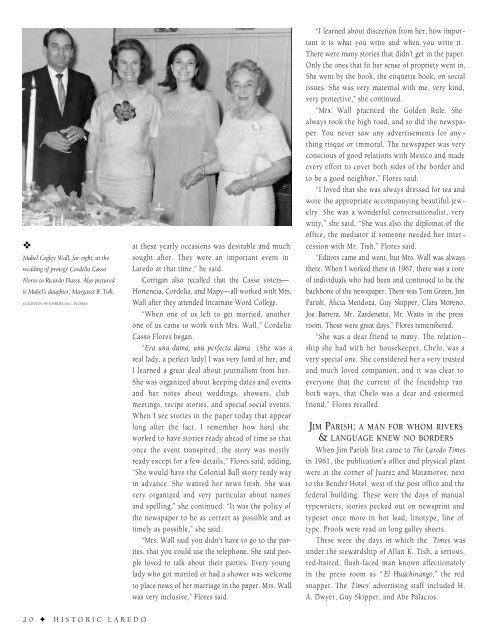Historic Laredo
An illustrated history of the city of Laredo and the Webb County area, paired with the histories of companies, families and organizations that make the region great.
An illustrated history of the city of Laredo and the Webb County area, paired with the histories of companies, families and organizations that make the region great.
Create successful ePaper yourself
Turn your PDF publications into a flip-book with our unique Google optimized e-Paper software.
❖<br />
Mabel Cogley Wall, far right, at the<br />
wedding of protege Cordelia Casso<br />
Flores to Ricardo Flores. Also pictured<br />
is Mabel’s daughter, Margaret B. Tish.<br />
COURTESY OF CORDELIA C. FLORES<br />
at these yearly occasions was desirable and much<br />
sought after. They were an important event in<br />
<strong>Laredo</strong> at that time,” he said.<br />
Corrigan also recalled that the Casso sisters—<br />
Hortencia, Cordelia, and Mapy—all worked with Mrs.<br />
Wall after they attended Incarnate Word College.<br />
“When one of us left to get married, another<br />
one of us came to work with Mrs. Wall,” Cordelia<br />
Casso Flores began.<br />
“Era una dama, una perfecta dama . (She was a<br />
real lady, a perfect lady) I was very fond of her, and<br />
I learned a great deal about journalism from her.<br />
She was organized about keeping dates and events<br />
and her notes about weddings, showers, club<br />
meetings, recipe stories, and special social events.<br />
When I see stories in the paper today that appear<br />
long after the fact, I remember how hard she<br />
worked to have stories ready ahead of time so that<br />
once the event transpired, the story was mostly<br />
ready except for a few details,” Flores said, adding,<br />
“She would have the Colonial Ball story ready way<br />
in advance. She wanted her news fresh. She was<br />
very organized and very particular about names<br />
and spelling,” she continued. “It was the policy of<br />
the newspaper to be as correct as possible and as<br />
timely as possible,” she said.<br />
“Mrs. Wall said you didn’t have to go to the parties,<br />
that you could use the telephone. She said people<br />
loved to talk about their parties. Every young<br />
lady who got married or had a shower was welcome<br />
to place news of her marriage in the paper. Mrs. Wall<br />
was very inclusive,” Flores said.<br />
“I learned about discretion from her, how important<br />
it is what you write and when you write it.<br />
There were many stories that didn’t get in the paper.<br />
Only the ones that fit her sense of propriety went in.<br />
She went by the book, the etiquette book, on social<br />
issues. She was very maternal with me, very kind,<br />
very protective,” she continued.<br />
“Mrs. Wall practiced the Golden Rule. She<br />
always took the high road, and so did the newspaper.<br />
You never saw any advertisements for any -<br />
thing risqué or immoral. The newspaper was very<br />
conscious of good relations with Mexico and made<br />
every effort to cover both sides of the border and<br />
to be a good neighbor,” Flores said.<br />
“I loved that she was always dressed for tea and<br />
wore the appropriate accompanying beautiful jewelry.<br />
She was a wonderful conversationalist, very<br />
witty,” she said. “She was also the diplomat of the<br />
office, the mediator if someone needed her inter -<br />
cession with Mr. Tish,” Flores said.<br />
“Editors came and went, but Mrs. Wall was always<br />
there. When I worked there in 1967, there was a core<br />
of individuals who had been and continued to be the<br />
backbone of the newspaper. There was Tom Green, Jim<br />
Parish, Alicia Mendoza, Guy Skipper, Clara Moreno,<br />
Joe Barrera, Mr. Zardenetta, Mr. Watts in the press<br />
room. Those were great days,” Flores remembered.<br />
“She was a dear friend to many. The relation -<br />
ship she had with her housekeeper, Chelo, was a<br />
very special one. She considered her a very trusted<br />
and much loved companion, and it was clear to<br />
everyone that the current of the friendship ran<br />
both ways, that Chelo was a dear and esteemed<br />
friend,” Flores recalled.<br />
JIM PARISH: A MAN FOR WHOM RIVERS<br />
& LANGUAGE KNEW NO BORDERS<br />
When Jim Parish first came to The <strong>Laredo</strong> Times<br />
in 1961, the publication’s office and physical plant<br />
were at the corner of Juarez and Matamoros, next<br />
to the Bender Hotel, west of the post office and the<br />
federal building. These were the days of manual<br />
typewriters, stories pecked out on newsprint and<br />
typeset once more in hot lead, linotype, line of<br />
type. Proofs were read on long galley sheets.<br />
These were the days in which the Times was<br />
under the stewardship of Allan K. Tish, a serious,<br />
red-haired, flush-faced man known affectionately<br />
in the press room as “ El Huachinango,” the red<br />
snapper. The Times’ advertising staff included H.<br />
A. Dwyer, Guy Skipper, and Abe Palacios.<br />
20 ✦ HISTORIC LAREDO
















